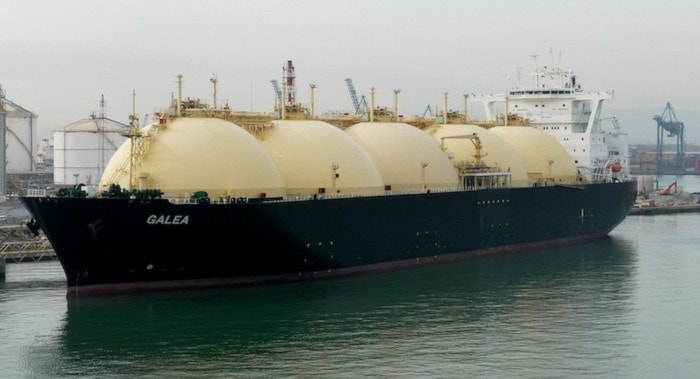Port officials have repeatedly asked the province to build a higher bridge when it replaces the Massey Tunnel to leave more room for taller ships – potentially large LNG tankers – to pass underneath and sail up the lower Fraser River.
The port's position is spelled out in internal Port Metro Vancouver emails obtained under Access to Information by the environmental group Voters Taking Action On Climate Change (VTACC).
The emails show port staff urged the province to design a taller bridge, even though that would mean higher costs, a more challenging design and a steeper grade for Highway 99 traffic on both approaches.
As of mid-2014, port officials were proposing the Massey Bridge be designed with an "air draft" – the clearance for a ship between the water line and the bottom of the bridge deck – of about 65 metres. That's significantly more than the 57 metres initially outlined by the province.
Port officials discussed the potential use on the Fraser of taller LNG tankers in arriving at their proposed design height.
"Liquid bulk tankers with larger air draft requirements (e.g. LNG) should be considered," port development strategies manager Jennifer Natland wrote in 2013.
A June 2014 briefing note by port officials following a meeting with provincial counterparts cautions "there are multiple challenges with high costs to achieve PMV's requested height" of 65 metres.
A month later, in a July email to his staff, Port Metro Vancouver CEO Robin Silvester asked: "What is the air draft of the largest length LNG vessel that we could imagine in the river?"
Port marine operations director Chris Wellstood responded a 63-metre air draft would be enough for "the larger part of the world's LNG fleet" – tankers up to 320 metres long – to pass under the new bridge and head up the Fraser.
The largest LNG tankers, carrying 267,000 cubic meters of liquefied natural gas, require 64.4 metres of air draft, while the average LNG tanker with 142,000 cubic metre capacity needs about 50 metres overhead clearance, according to a chart Wellstood included.
Port Metro Vancouver planning and operations vice-president Peter Xotta said discussions about the bridge height are "ongoing" with the province, adding he expects the final decision will be close to 60 metres, but less than the port's preferred 65 metres.
"We would like to give ourselves the maximum flexibility," Xotta said in an interview. "But we recognize the constraints – technical and financial – that the province is under."
Fortis BC is expanding its LNG facility on the Fraser River in Delta at Tilbury Island and WesPac Midstream LNG has proposed an adjoining marine terminal that would export Fortis LNG via barge and tanker.
WesPac has a newly approved licence to export 3.5 million tonnes of LNG a year and plans to use mid-size tankers of no more than 80,000 cubic metres capacity.
The WesPac LNG project is undergoing a provincial environmental assessment but proponents hope to be shipping LNG supplied by Fortis in 2016.
Xotta said the port's push for a higher bridge isn't about any specific proposal or scenario, but ensuring the most potential options for the long term.
Cruise ships are the only other tall vessels besides LNG tankers that Xotta was able to point to as requiring maximum air draft.
He said the river is suitable only for mid-sized vessels as there are other navigation constraints, including the ability to turn ships around in the river.
The port has made no secret it wants the Massey Tunnel removed so ships that sit deeper in the water can pass upstream, but it had not publicly indicated before now that the height of the replacement bridge is also a concern.
The Alex Fraser Bridge height is 57 metres above the river, so a taller Massey Bridge could only be of use to ships of above-average height heading to Delta river terminals such as Tilbury Island, not further upriver to Fraser Surrey Docks.
"The industrial properties that the port would be interested in serving are not beyond the Alex Fraser," Xotta said. "So conceivably you could have a higher bridge at George Massey to facilitate trade and the height of the Alex Fraser wouldn't have a direct bearing on that."
VTACC spokesman Kevin Washbrook questioned whether LNG tankers might pose a risk to residents near the river in Delta or Richmond.
"Is it safe or appropriate to have an LNG terminal on the Fraser River?" he asked. "It seems preposterous."
If the province opts to build the bridge higher to satisfy port planners, Washbrook said, B.C. taxpayers shouldn't have to pay the extra costs.
"I think there's a clear argument for the federal government contributing to the cost," he said.
"We're being sold this bridge as a benefit for commuters. But if it's about other things we should have that discussion and see if it's in the interest of the public and not just industrial users."
Delta South MLA Vicki Huntington said she understands LNG to be safe and stable at high pressure, posing no significant safety or environmental risk.
But she said the debate over the bridge height reinforces her position that the port or its customers must contribute to the Massey Tunnel replacement costs.
"The port has to help build this thing."
Xotta declined to comment on potential cost sharing by the port.
Provincial transportation ministry officials would only say that bridge height discussions are continuing and the project definition report will spell out design details and costs in the coming months.
